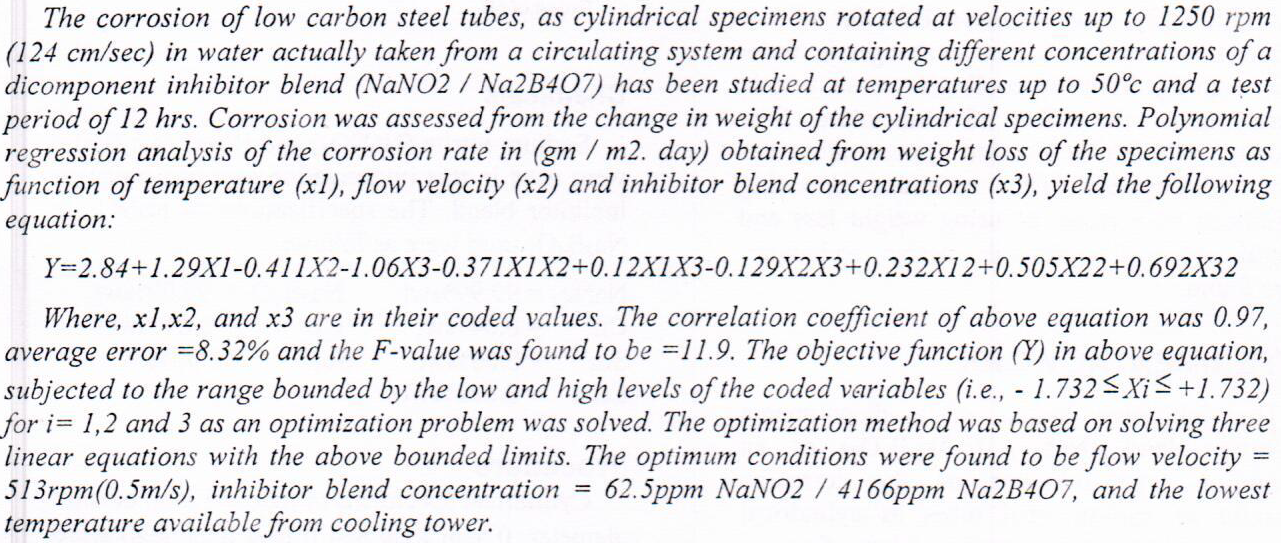
Water flow into unsaturated porous media is governed by the Richards’ partial differential equation expressing the mass conservation and Darcy’s laws. The Richards’ equation may be written in three forms,where the dependent variable is pressure head or moisture content, and the constitutive relationships between water content and pressure head allow for conversion of one form into the other. In the present paper, the “moisture-based" form of Richards’ equation is linearized by applying Kirchhoff’s transformation, which
combines the soil water diffusivity and soil water content. Then the similarity method is used to obtain the analytical solution of wetting front position. This exact solution is obtained by means of Lie’s
 (2)
(2)
 (23)
(23)
 (17)
(17)
 (23)
(23)
 (17)
(17)
This work aims to investigate the inhibition of vitality of Streptococcus mutans, which is the causative agent of caries. A 632.8 nm He-Ne laser with the output power of 4.5mW was used in combination with toluidine blue O (TBO) at the concentration of 50μg/ml as a photosensitizer. Streptococcus mutans was isolated from 35 patients if carious teeth. Three isolates were chosen and exposed to different energy densities of He – Ne laser light 3.8, 11.7, 34.5 and 104.1 J/cm². After irradiation, substantial reduction was observed in the number of colony forming units (CFU)/ ml. The reduction in the number of CFU was increasing as the dose increased.
 (8)
(8)
The research aims to study the effect of adding (Li2O) to an alkaline glaze containing (K2O, Na2O). Although all the alkaline oxides have common properties, each oxide has something that distinguishes it. The molecular weight of (Li2O) is two times less than that of (Na2O) and three times that of (K2O). Therefore, it is added in small proportions. In addition, it is a very strong flux, so it is not used alone, but rather replaces a part of other alkaline oxides. It was added to an alkali glass that matured at a temperature of 980CO in proportions (2.0,1.4,1.2,0.8,0.4%) instead of (Na2O), using lithium carbonate (Li2CO3) as an oxide source. The glazes mixtures were applied to a white pottery body, and the samples were fired and cooled acc
... Show MoreThe galvanic corrosion of the (Cu - Fe), (Cu - Zn) and (Fe - Zn) couples have been investigated in 3.5% NaCl solution, 40ºC, different velocities (Re = 5000, 10000 and 15000) and different area ratio’s of cathode to anode (AR= 0.5,1 and 2), by using commercial metal pipe (cylindrical tube).The Zero Resistance Ammeter has been used to measure the galvanic current (Ig) and galvanic potential (Eg) with time. The galvanic current density increases with increasing velocity (Re) and the area ratio (AR). The galvanic potential (Eg) is shifted to less negative with increasing velocity (Re) and the area ratio (AR). A statistical relations for the galvanic current density and galvanic potential as a function of (Re). and the area ratio had been
... Show MoreThis work reports the study of heat treatment effect on the structural, morphological, optical and electrical properties of poly [3-hexylthiophene] and its blend with [6,6]-phenyl C61 butyric acid methyl ester ( P3HT:PC61BM). X-ray diffraction (XRD) measurements show that the crystallinity of the films increased with annealing. The evaluation of surface roughness and morphology was investigated using atomic force microscope (AFM), and field emission scanning microscope(FESEM). The optical properties were emphasized a strong optical absorption of P3HT compared with the blend. Hall effect measurement was used to study the electrical properties which revealed there is an increase in the electrical conductivity and Hall mobility of th
... Show More (1)
(1)
The aim of this research is to calculate mass transfer coefficient, kd, during cathodic protection of low carbon steel in neutral seawater (3.5% W/V NaCl in distilled water with pH = 7). Two types of cathodic protection were used:
First: Sacrificial anode cathodic protection (SACP) were a pipeline of steel carrying seawater using zinc as a sacrificial anode and with variable temperatures ranged (0 – 45oC) and volumetric flow rate ranged (5 – 900 lit/hr). It was found that the kd increases with increasing temperature and volumetric flow rate of seawater, where kd ranged (0.24×10-6 – 41.6×10-6 m/s).
Second: Impressed current cathodic pr
... Show MoreThe behavior corrosion inhibition of aluminum alloy (Al6061) in acidic (0.1 M HCl) and saline (3.5% NaCl) solutions was investigated in the absence and the presence of expired diclofenac sodium drug (DSD) as a corrosion inhibitor. The influence of temperature and was studied using electrochemical techniques. In addition, scanning electron microscopy (SEM) was used to study the surface morphology. The results showed that DSD acted as a powerful inhibitor in acidic solutions, while a moderate influence was observed with saline one. Maximum inhibition efficiency was 99.99 and 83.32% in acidic and saline solutions at 150 ppm of DSD, respectively. Corrosion current density that obtained using electrochemical technique was increased with temperat
... Show More (44)
(44)
 (40)
(40)
